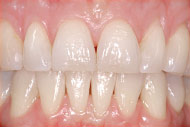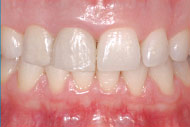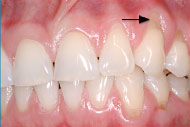Genetics & Gum Tissue Types
Thick vs. Thin Gum Tissue Types — Which type are you and what does it mean for your dental health?
Dear Doctor,
My dentist told me my gums were receding, and that I had a “thin tissue type.” Could you explain what this means and what the implications might be?
 |
| Figure 1: An example of a thin/scalloped tissue type. Notice the triangular shaped tooth form and the soft tissue appearance. |
 |
| Figure 2: An example of a thick/flat tissue type. Notice the square shaped tooth form and the soft tissue appearance. |
 |
| Figure 3: A classic example of a thin/scalloped tissue type that has undergone gingival (gum) recession. |
Dear Millie,
Your dentist has identified the two basic types of gum tissues, termed by dentists as “Periodontal Biotypes.” Although there are variations found in all populations, we generally think of two types — “thin/scalloped” [Figure 1] and “thick/flat” [Figure 2]. These refer to the actual consistency (or thickness) of the gum tissue and underlying bone, as well as the forms of the surrounding tissues.
The major factor that determines what particular biotype you are is the shape of your teeth. A triangular-shaped tooth usually results in a thin/scalloped form [Figure 1]; a squarer tooth usually results in the thick/flat form [Figure 2]. Since our tooth shapes are genetically-coded, we have no control over these shapes or the ultimate forms of the surrounding gum tissue and bone — another thing we can blame on our parents!
Furthermore, a growing line of evidence now indicates that different racial groups characteristically have different tooth forms. For example, a higher proportion of Caucasians and Blacks have a square tooth shape, while Asians commonly have a more triangular shape.
Thin Tissue Types — More Susceptible to Gum Recession
Problems can arise from the thin tissue type, most notably gum recession [Figure 3]. This can occur around any tooth, but it's most obvious with the front teeth. There are a few signs that may indicate gum recession:
- Sensitivity to cold (as when you eat ice cream), even where no dental decay is present.
- A dark gray line at the gum line in patients who have crowns on their teeth — the gray color comes from the metal casting beneath the porcelain material of the crown.
- Small dark triangular spaces between adjacent teeth as the papillae are lost — the pink gum tissue that normally completely fills the space between the teeth.
Thick Tissue Type — More Susceptible to Periodontal Pocketing
Thicker tissue types are susceptible to dental disease through a condition known as “pocketing.” Dental bacterial plaque causes a thicker tissue type to become inflamed, lose its tight attachment to the tooth and develop a “pocket.” Like putting your hand in a pocket, a dentist can place a small calibrated probe in a periodontal pocket to assess the millimeters of detachment. Pocketing results in bone loss and can ultimately jeopardize the life of the tooth.
Thick or thin? The two terms as well as anything else allow the dentist to categorize different tissue types for clinical decision making. However, many people's tissues fall somewhere in between the two varieties.
Treatment and Prevention
The obvious question then is: what can my dentist and I do about this? Since you can't do anything about your inherited tissue type, you must take every possible precaution to prevent periodontal disease. If this disease develops, gum recession will usually follow in the thinner areas, along with the breakdown of the underlying bone (what dentists call resorption) while in the thicker areas you're prone to pocketing. Good daily oral hygiene is the best starting point. You should use a soft toothbrush and floss regularly, but with great care — overzealous flossing that goes too deep below the gum line can cause an injury similar to a paper cut and can result in recession.
If recession does occur, all is not lost. Your dentist may utilize periodontal plastic surgical techniques to “graft tissue” — tissue taken from another part of the mouth and surgically placed around the recession — to prevent further damage.
Obviously, your dentist recognizes the potential problems you can have with your thin tissue type and will take special care to prevent recession. Since you're now both alerted to the problem, I'm confident you and your dentist will take the necessary precautions to prevent compromising your dental health.



